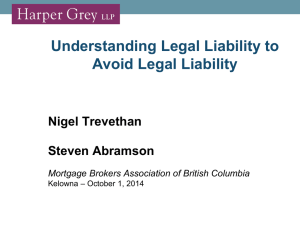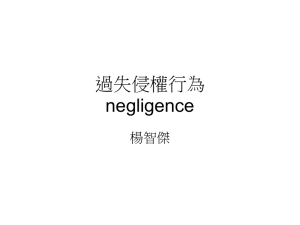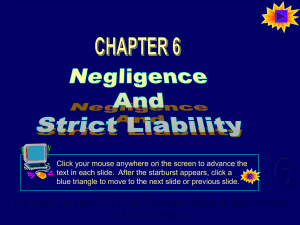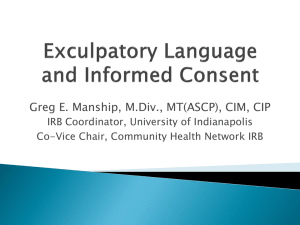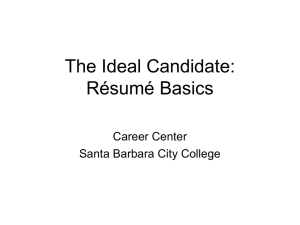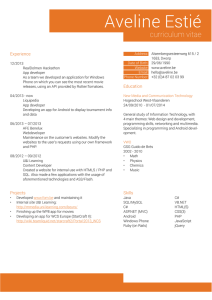involve the public interest
advertisement
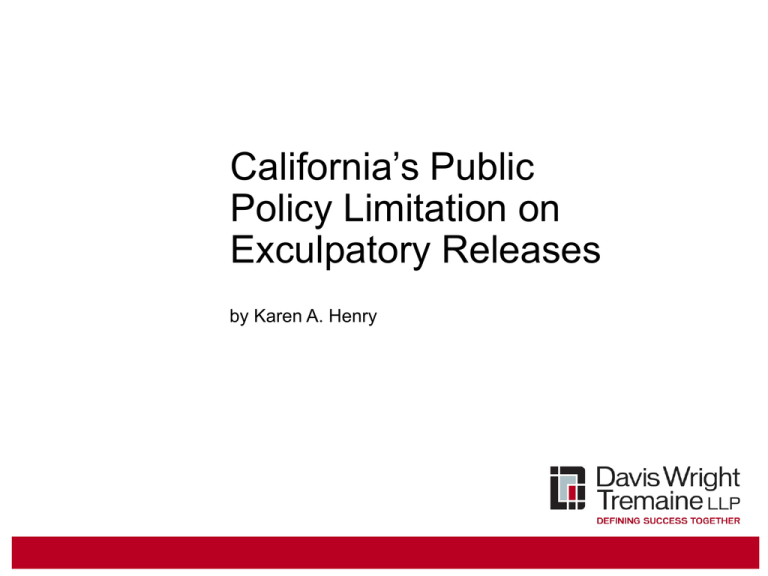
California’s Public Policy Limitation on Exculpatory Releases by Karen A. Henry “Drafters of releases always face the problem of steering between the Scylla of simplicity and the Charybdis of completeness, … only on draftsman’s Olympus is it feasible to combine the elegance of a trust indenture with the brevity of a stop sign.” Nat’l & Int’l Brotherhood of Street Racers, Inc. v. Superior Court, 215 Cal. App. 3d 934, 938-939 (1989). Three Prerequisites to Enforcement: To be enforceable, a release must exhibit the following three characteristics: 1. It must be clear, unambiguous and explicit in expressing the intent of the parties; 2. The injury-causing act must be reasonably related to the object or purpose for which the release is given; and 3. The release cannot contravene public policy. See Madison v. Superior Court, 203 Cal. App. 3d 589, 598 (1998). California Civil Code § 1668 “All contracts which have for their object, directly or indirectly, to exempt anyone from responsibility for his own fraud, or willful injury to the person or property of another, or violation of law, whether willful or negligent, are against the policy of the law.” Against the policy of the law? What does that mean? An exculpatory provision is “against the policy of the law” if: It violates the express language of Section 1668; or It “involves the public interest.” Violates the express language of Section 1668: Section 1668 specifically proscribes contracts that purport to release anyone from liability for fraud, willful injury to the person or property of another, or a violation of law. The following claims thus fall within the statute’s express language: Claims That Cannot Be Released: Fraud; Negligent Misrepresentation; Violation of law; Negligence Per Se (arising from an alleged statutory violation); Any intentional tort; and Gross negligence (maybe; stay tuned…). What’s not on the list? Section 1668 does not proscribe a contract that releases a person/entity from liability for ordinary negligence, provided the transaction does not “involve the public interest.” “Involves Public Interest?” What does this mean? How do you determine whether an exculpatory provision “involves the public interest?” Examine the Nature of the Transaction: To determine whether an agreement releasing liability for ordinary negligence is enforceable, courts are directed to examine “the overall transaction – with special emphasis upon the importance of the underlying service or program, and the relative bargaining relationship of the parties.” City of Santa Barbara v. Superior Court, 41 Cal. 4th 747, 762 (2007). Tunkl v. The Regents of the Univ. of Calif., 60 Cal. 2d 92 (1963). Facts: Plaintiff brought action to recover damages for personal injuries that he allegedly suffered as a result of the negligence of two physicians employed by the University of California Los Angeles Medical Center; The plaintiff had been admitted to the hospital as a patient, and, upon his entry, he signed a document setting for certain “Conditions of Admission”; Condition #6 “Release: The hospital is a nonprofit, charitable institution. In consideration of the hospital and allied services to be rendered and the rates charged therefor, the patient or his legal representative agrees to and hereby releases The Regents of the University of California, and the hospital from any and all liability for the negligent or wrongful acts or omissions of its employees, if the hospital has used due care in selecting its employees.” Plaintiff stipulated that the hospital had selected its employees with due care. The jury returned a verdict sustaining the validity of the release, and judgment was entered in favor of the Regents. Court first examined how lower appellate courts had interpreted Section 1668. “The course of section 1668 … has been a troubled one.” Id. at 95. Some cases had interpreted the statute strictly; One case limited the phrase “negligent violation of laws” exclusively to violations of statutory law; Other cases had held that the statute prohibits the exculpation of gross negligence only; Another case held that the statute forbids exemption from active as contrasted with passive negligence. Despite diverse interpretations, decisions were uniform in one respect: Cases uniformly held that “[an] exculpatory provision may stand only if it does not involve “the public interest.” Id. at 96. What is “the public interest” in this context? “No definition of the concept of public interest can be contained within the four corners of a formula. The concept, always the subject of great debate, has ranged over the whole course of the common law; rather than attempt to prescribe its nature, we can only designate the situations in which it has been applied.” Id. at 98. Transactions “Stamp[ed]” As Involving “the Public Interest”: The Court identified the following six transactions as characteristic of the types of transactions in which exculpatory provisions will be held invalid (“the Tunkl factors”): First Tunkl Factor: The transaction “concerns a business of a type generally thought suitable for public regulation.” Second Tunkl Factor: “The party seeking exculpation is engaged in performing a service of great importance to the public, which is often a matter of practical necessity for some members of the public.” Third Tunkl Factor: “The party holds himself out as willing to perform this service for any member of the public who seeks it, or at least for any member coming within certain established standards.” Fourth Tunkl Factor: “As a result of the essential nature of the service, in the economic setting of the transaction, the party invoking exculpation possesses a decisive advantage of bargaining strength against any member of the public who seeks his services.” Fifth Tunkl Factor: “In exercising a superior bargaining power the party confronts the public with a standardized adhesion contract of exculpation, and makes no provision whereby a purchaser may pay additional reasonable fees and obtain protection against negligence.” Sixth (and final) Tunkl Factor: “[A]s a result of the transaction, the person or property of the purchaser is placed under the control of the seller, subject to the risk of carelessness by the seller or his agents.” But these are voluntary transactions! “While obviously no public policy opposes private, voluntary transactions in which one party, for a consideration, agrees to should a risk which the law would otherwise have placed upon the other party, the above circumstances pose a different situation. In this situation, the releasing party does not really acquiesce voluntarily in the contractual shifting of the risk, nor can we be reasonably certain that he receives an adequate consideration for the transfer. Since the service is one which each member of the public, presently or potentially, may find essential to him, he faces, despite his economic inability to do so, the prospect of a compulsory assumption of the risk of another’s negligence.” Must all of the Tunkl factors be present: Unclear; but probably not. Tunkl court said that “the agreement need only fulfill some of the characteristics” to “involve the public interest” and, thus, be unenforceable. Subsequent cases have not adhered to this dicta. In Kurashige v. Indian Dunes, Inc., 200 Cal. App. 3d 606 (1988), in evaluating a release signed by a motorcycle dirt-bike rider, the court cited all six Tunkl factors but discussed only four of them. The court found that defendants' dirt bike business "did not involve the public interest: defendants' business was not generally thought to be suitable for public regulation; defendants did not perform a service of great importance to the public, and the business was not a matter of practical necessity for members of the public; and defendants' customers did not place their persons under defendants' control." 200 Cal. App. 3d at 612. In Madison v. Superior Court, 203 Cal. App. 3d 589, 599 (1988) the court also cited all six Tunkl factors, and then broadly declared that "[t]his case involves no more a question of public interest than does motorcross racing, sky diving, or motorcycle dirt-bike riding.“ (Internal citations omitted). Similarly, in Hulsey v. Elsinore Parachute Center, 168 Cal. App. 3d 333, the court identified all six Tunkl factors and then discussed some of them: "Applying the Tunkl factors to the facts here, several distinctions are readily apparent. First, parachute jumping is not subject to the same level of public regulation as is the delivery of medical and hospital services. Second, the Tunkl agreement was executed in connection with services of great importance to the public and of practical necessity to anyone suffering from a physical infirmity or illness. Parachute jumping, on the other hand, is not an activity of great importance to the public and is a matter of necessity to no one. Finally, because of the essential nature of medical treatment, the consuming party in Tunkl had little or no choice but to accept the terms offered by the hospital. Defendant had no decisive advantage in bargaining power over plaintiff by virtue of any ‘essential services’ offered by defendant." 168 Cal. App. 3d at 342-343. What have we learned so far? Individuals/entities cannot exculpate themselves from fraud, negligence per se, statutory violations, or any intentional torts; but Individuals/entities can exculpate themselves from ordinary negligence, if the transaction does not “involve the public interest.” What about gross negligence? City of Santa Barbara v. Superior Court, 41 Cal. 4th 747 (2007). The mother of a developmentally disabled 14-year- old girl signed an application form releasing the City of Santa Barbara and its employees from liability for “any negligent act” related to her daughter’s participation in the City’s summer camp for developmentally disabled children. Her daughter drowned while attending the camp, and she brought a wrongful death action against the City alleging that the accident was caused by the City’s negligence. The City alleged that the release barred the claim, and moved for summary judgment, which the trial court denied. The City then filed a petition for writ of mandate, which was denied by the Court of Appeal, which concluded that, although the agreement was effective and enforceable relative to the City’s liability for future ordinary negligence, it was ineffective to release the City from liability for gross negligence. California Supreme Court Held: “[A]n agreement purporting to release liability for future gross negligence committed against a developmentally disabled child who participates in a recreational camp designed for the needs of such children violates public policy and is unenforceable.” Does City of Santa Barbara make unenforceable any exculpation of gross negligence? Probably: The California Supreme Court’s holding in City of Santa Barbara was very narrow; But the Court did broadly announce the rule that “public policy generally precludes enforcement of an agreement that would remove an obligation to adhere to even a minimal standard of care.” 41 Cal. 4th at 777 (emphasis in original); At least one reported case reads City of Santa Barbara as holding that “a release exculpating a city from liability for ‘any negligent act’ did not extend to acts of gross negligence”). Booth v. Santa Barbara Biplanes, Inc., 158 Cal. App. 4th 1173 (2008) (simple negligence case). Is exculpation of gross negligence against public policy per se, or should courts still apply the Tunkl factors? In City of Santa Barbara the Court did not apply Tunkl’s “transaction-focused” analysis, but instead employed the public policy rationale of out-of-state decisions that focuses on “the degree or extent of the misconduct at issue, in order to discourage (or at least not facilitate) aggravated wrongs.” Since the Court did not apply the Tunkl factors in reaching its holding in City of Santa Barbara, it does not appear that the Tunkl factors are relevant to the analysis. Thus, like fraud, claims for gross negligence probably are not releasable in California, irrespective of whether the transaction “involved the public interest.” Disclaimers To provide some protection from fraud and negligent misrepresentation claims, some producers include language in the releases whereby the show participant expressly acknowledges that no representations have been made to them other than those expressly set forth in the release. A disclaimer of this type might establish that the show participant’s reliance on the alleged misrepresentations was not justifiable. Can an ordinary integration clause serve this purpose? “A party to a contract who has been guilty of fraud in its inducement cannot absolve himself from the effects of his fraud by any stipulation in the contract, either that no representations have been made, or that any right which might be grounded upon them is waived. Such a stipulation or waiver will be ignored, and parol evidence of misrepresentations will be admitted, for the reason that fraud renders the whole agreement voidable, including the waiver provision.” Greenspan Volkswagen v. Ford Motor, 32 Cal. App. 4th 985, 994 n.7 (1995) citing 1 Witkin, Summary of Cal. Law, Contracts, § 410, pp. 368369. Hinesley v. Oakshade Town Center, 135 Cal. App. 4th 289, 301 (2005). An integration clause may weigh against justifiable reliance when the clause in question is narrowly tailored to gauge against the particular misrepresentations at issue in the case. In Hinesley, the plaintiff had signed a lease with a shopping mall developer after the developer made certain representations about the mall’s future tenants. When those tenants did not lease space at the mall, the plaintiff sued the developer for rescission and fraudulent concealment, claiming that it never would have signed the lease but for the developer’s misrepresentations about the other anticipated tenants. The court refused to invalidate the agreement, however, because it included terms by which the plaintiff specifically disclaimed any reliance on statements about the identity of those tenants. Hinesley Disclaimer “Lessee does not rely on the fact nor does Lessor represent that any specific Lessee o[r] type or number of Lessees shall during the term of this Lease occupy any space in the Shopping Center.”

